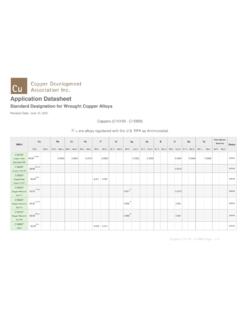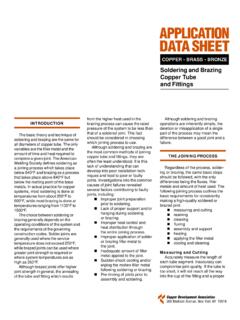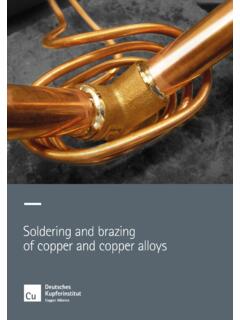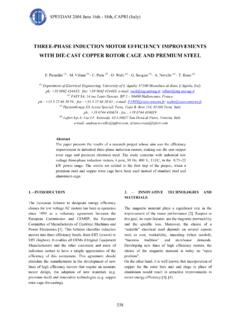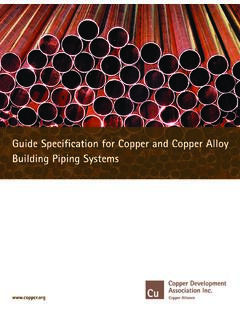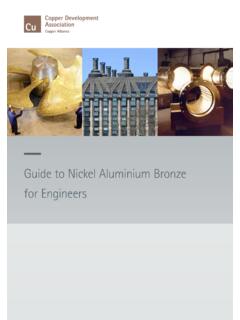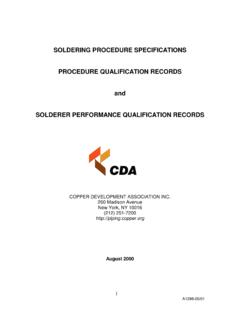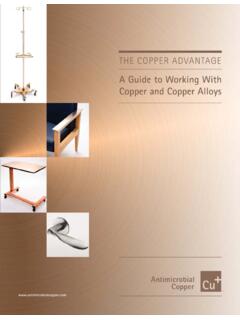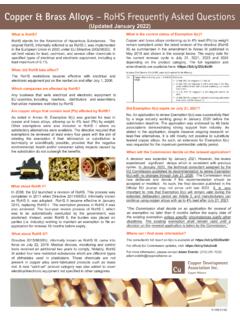Transcription of Recommended machining parameters for copper and copper …
1 Recommended machining parameters for copper and copper alloysDKI Monograph by:German copper Institute / Deutsches Kupferinstitut Information and Advisory Centre for the Use of copper and copper AlloysAm Bonneshof 540474 D sseldorfGermanyTel.: +49 (0)211 47963-00 Fax: +49 (0)211 rights run 2010 Revised and expanded by:Laboratory for Machine Tools and Production Engineering WZL at RWTH Aachen UniversityProf. Dr. Fritz Dieter Klaus Patrik Susanne CordesFraunhofer Institute for Production Technology IPT in Frank NiehausTranslation:Dr. Andrew Symonds BD Picture credits:TORNOS, Pforzheim; Wieland-Werke, Ulm Kindly supported by International copper Association, New York DKI Monograph | 1 ContentsContents.
2 1 Foreword ..21 The situation today ..32 Fundamental principles ..5 Tool geometry and how it influences the cutting process ..5 Tool geometry ..5 Effect of tool geometry on the cutting process ..6 Tool wear ..10 Chip formation ..113 Machinability ..13 Tool life ..13 Cutting force ..15 Surface quality ..18 Chip shape ..214 Classification of copper -based materials into machinability groups ..23 Standardization of copper materials ..23 Machinability assessment criteria ..23 The effect of casting, cold forming and age hardening on machinability.
3 24 Alloying elements and their effect on machinability ..25 Classification of copper and copper alloys into main machinability groups ..285 Cutting-tool materials ..32 High-speed steel ..32 Carbides ..32 Diamond as a cutting material ..33 Selecting the cutting material ..346 Cutting-tool geometry ..35 Rake and clearance angles ..357 Cutting fluids ..378 Calculating machining costs ..389 Ultra-precision machining of copper ..40 Principles of ultra-precision Example applications involving copper alloys 40 Work material properties and their influence on ultra-precision machining .
4 4110 Recommended machining parameters for copper and copper alloys ..43 Turning of copper and copper alloys ..43 Drilling and counterboring of copper and copper alloys ..44 Reaming copper and copper alloys ..46 Tapping and thread milling copper and copper alloys ..46 Milling copper and copper alloys ..4711 Appendix ..49 Sample machining Mathematical formulae ..56 Equations ..56 symbols and abbreviations ..5813 References ..6114 Standards, regulations and guidelines ..632 | DKI Monograph Recommended machining parameters for copper and copper alloys contin-ues a long tradition established by the German copper Institute (DKI).
5 The publication Processing copper and copper Alloys ( Das Bearbeiten von Kupfer und Kupferlegierungen ) first appeared in 1938 and again in 1940. The handbook Metal cutting tech-niques for copper and copper alloys ( Die spanabhebende Bearbeitung von Kupfer und Kupferlegierungen ) by J. Witthoff, which was published in 1956, represented a thorough revision and rewriting of the earlier work. The new handbook included for the first time a complete overview of all the standardized copper materials and metal cutting data known at the time. In addition to the easily machinable free-cutting brass, the handbook also gave an account of copper alloys that had been developed for specific appli-cations and that were often far harder to machine.
6 In 1987 large sections of the handbook were reorganized, revised and updated by Hans-J rn Burmester and Manfred Kleinau and re-issued under the current title Recommended machining parameters for copper and copper alloys (German original: Richtwerte f r die spanende Bearbeitung von Kupfer und Kupferle-gierungen ). The handbook included Recommended machining parameters for all relevant machining techniques for a broad range of copper order to take account of recent technical developments in the field, the handbook has once again been revised and updated while retaining the previous title.
7 Like its predecessors, this edition of the handbook has been designed to address the concerns of practitioners, helping them to find the most effec-tive and economical solutions to their metal cutting problems. It also aims to assist designers and development engineers when comparing the machin-ability of different materials, making it easier for them to estimate the fab-rication costs of a particular part. Ma-chinability index ratings have therefore been added to the tables included in the handbook. Machinability ratings are commonplace in the specialist literature and not only help to make comparisons between different copper materials but also comparisons with other metallic materials such as steel or tables have also been brought up to date to reflect the most recent materials standards, and the tables of reference values for the various machining methods have been revised and expanded.
8 As the machinability of a material is highly complex and depends on a large number of fac-tors, the benchmark values provided here can only offer broad guidance. To establish the optimal machining pa-rameters for a specific production pro-cess and thus optimize the productivity and cost-efficiency of that process, additional cutting and machining tests under the actual production conditions must be carried DKI Monograph | 3 Compared to other metallic structural materials, most copper -based materials are relatively easy to machine. The free- cutting brass with the designation cuzn39pb3 has established itself as an excellent material for manufactur-ing all kinds of form turned parts.
9 The excellent machining properties of these copper -zinc alloys is so well-known that they are often used as benchmarks for describing the machining properties of copper and copper alloys machining copper alloys is considerably easier than machining steels or alumin-ium alloys of the same strength (see Figure 1). This is reflected in the signif-icantly lower cutting forces as shown in Figure 2. Unless specific technical requirements dictate the use of another material , free-cutting brass cuzn39pb3 is the material of choice in contract turning and machining shops and CNC turning shops.
10 Parts that are mass-manufactured are typically machined from copper materi-als. In order to meet a very wide range of technical and engineering require-ments, a great number of copper -based materials have been developed over the years. Examples of more recent developments include the low-alloyed copper alloys, copper -nickel alloys and lead-free copper alloys. The spectrum of materials available ranges from the high-strength copper -aluminium alloys to the very soft pure coppers with their high elongation after fracture. The differences in the machinability of one material compared to that of another can be traced to the differences in their mechanical and physical prop-erties.
